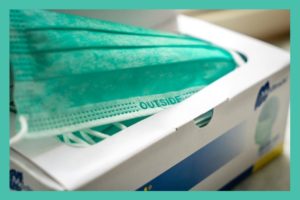10 Tips for Improving Patient Interactions
 In an editorial published in the Journal of the American Medical Association (JAMA) on July 14, 2020, the Centers for Disease Control and Prevention (CDC) affirmed that face coverings play a critical role in curtailing the spread of COVID-19. While widespread face mask adoption is undoubtedly the most viable solution in preventing the spread of COVID-19, this practice has resulted in unintended consequences, especially for those within the medical community. Given the fact that both patient and physician are now wearing a face mask that obscures facial expressions and distorts vocal patterns, it is little wonder that medical interactions are being increasingly characterized as confusing and stressful. With no foreseeable end to the need for face masks in sight, what can clinicians do to promote more successful interactions?
In an editorial published in the Journal of the American Medical Association (JAMA) on July 14, 2020, the Centers for Disease Control and Prevention (CDC) affirmed that face coverings play a critical role in curtailing the spread of COVID-19. While widespread face mask adoption is undoubtedly the most viable solution in preventing the spread of COVID-19, this practice has resulted in unintended consequences, especially for those within the medical community. Given the fact that both patient and physician are now wearing a face mask that obscures facial expressions and distorts vocal patterns, it is little wonder that medical interactions are being increasingly characterized as confusing and stressful. With no foreseeable end to the need for face masks in sight, what can clinicians do to promote more successful interactions?
We asked clinicians from multiple specialties how they are overcoming the face mask communication barrier. Below are the best recommendations that we received:
1. Get the Patient’s Attention
Before you begin speaking, make sure that you have your patient’s attention. One effective way to do this is to allow a moment or two of silence to pass before you begin speaking. In those moments of silence, establish eye contact with your patient. This simple practice is a great way to calm your and your patient’s mind and to focus your attention on the interaction that is about to happen. Once you are sure that your patient is keyed in, you can begin your visit.
2. Say Their Name
People love to hear their name spoken aloud. In fact, studies have proven that our brains involuntarily respond to the sound of our own name (even when we are in a vegetative state). To better remember your patient’s name, repeat it to yourself several times before you enter the room. Then be sure to use it throughout the interaction. Hearing their name spoken aloud will not only grab the patient’s attention, it will foster better communication by creating a sense of familiarity. In turn, this familiarity will lower levels of stress and anxiety.
3. Acknowledge What They Said
Repeating back in your own words what the patient has just said is a surefire way to let your patient know that you have heard and understood them. When you do this, it is helpful to use phrases like “If I understand you correctly…” and “Would you say that’s accurate?”. Using this technique throughout your interaction will ensure that your patient has an opportunity to clarify or correct any misinformation along the way. Doing this will save both you and your patient a lot of time and confusion.
4. Enunciate
The ability to clearly hear what a person is saying is greatly diminished when the speaker is wearing a face mask. This is especially true for those that have a quieter voice and for those that tend to speak more quickly. For this reason, it is extremely important that you take the time to speak more slowly and in a louder voice than what you would typically use for a patient visit. Carefully enunciate each of your words. Remember, there’s a substantial difference between the way you hear yourself and the way your patient is hearing you.
5. Smile
 Even though your mouth is hidden behind a mask, be sure to wear a smile when you are with your patients. It changes the sound of your voice and is even noticeable in the way your eyes narrow or crinkle-up. When a patient senses that you are smiling, they are likely to smile back at you. The dopamine, endorphins and serotonin that are released when you and your patient are both smiling are sure to foster a more relaxed environment where you both can be heard.
Even though your mouth is hidden behind a mask, be sure to wear a smile when you are with your patients. It changes the sound of your voice and is even noticeable in the way your eyes narrow or crinkle-up. When a patient senses that you are smiling, they are likely to smile back at you. The dopamine, endorphins and serotonin that are released when you and your patient are both smiling are sure to foster a more relaxed environment where you both can be heard.
6. Watch Your Body Language
Body language is a powerful way to communicate kindness and empathy and to help fill the non-verbal communication gaps that result from wearing a face mask. Lean towards the patient to communicate an interest in what they have to say. As the patient is talking, nod your head in agreement to demonstrate that you hear and understand what they are saying. Use your hands to gesture and point to parts of the body. Exaggerate your eye and eyebrow movements to help convey the appropriate emotion (i.e. eyes crinkled and eyebrows pulled down to show confusion or contemplation).
7. Use a Variety of Resources
One way to eliminate the breakdown in communication caused by wearing a face mask is to have and use a variety of creative communication aides. For instance, a simple dry erase board can be used during patient visits to capture main concepts and keywords. Simple anatomy worksheets can help the patient better explain the source of their pain and can help you communicate how the treatment plan is going to work. It doesn’t need to be technical or sophisticated. Use the resources that are readily available in your office.
8. Summarize
At the end of each visit, take the time to summarize the main points from the conversation you just had. This repetition will help the patient remember key takeaways that could otherwise be forgotten due to heightened nervousness. After you’ve finished summarizing the visit, be sure to ask the patient if they have any other questions they want to ask. This simple prompt communicates your willingness to address any lingering concerns before the appointment is over.
9. Remain Calm
You’re bound to hit a few bumps in the road as you and your patients navigate conversations from behind a mask. It is easy to become agitated or frustrated when your patient doesn’t understand you or vice versa. In those instances, remember to pause and take a breath. Heightened emotions are more likely to exacerbate the situation. Before you mask up for the visit, place a drop of peppermint oil (or other calming essential oil) just below your nose. This smell will help you naturally relax and will be a reminder to slow down, take a breath and remain calm.
10. Practice
Becoming a good communicator while wearing a face mask takes time. To cut down on your learning curve, partner with a colleague and have practice conversations while you both wear your mask. Use the words and phrases that are most common to your specialty and ask your partner for feedback. Could they hear you clearly? Were there any words or phrases that sounded garbled? Is there a routine part of your conversations that they think could be enhanced with a visual aide? Solicit their honest feedback so that you can provide your patients with the best experience possible.
 Effective communication with your patients while you are both wearing a face mask is undoubtedly challenging. However, these tips, combined with your own experience and creativity, are sure to help foster interactions that are meaningful and beneficial. We’d love to know what advice you have for communicating from behind the mask.
Effective communication with your patients while you are both wearing a face mask is undoubtedly challenging. However, these tips, combined with your own experience and creativity, are sure to help foster interactions that are meaningful and beneficial. We’d love to know what advice you have for communicating from behind the mask.
Please share your insights for improving patient communication while wearing a mask below.
